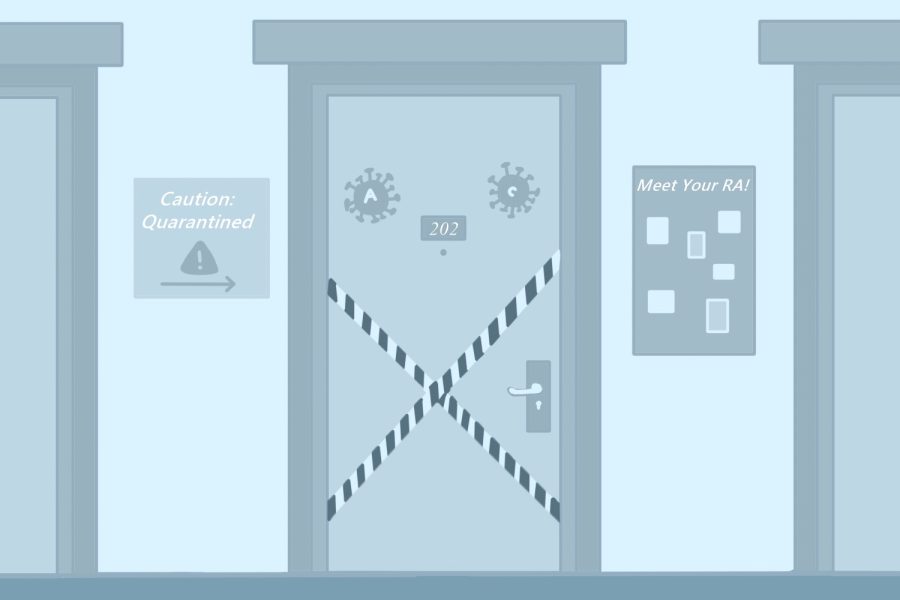UVM needs to bring back COVID-19 housing
September 21, 2022
As a warm welcome to my first week at UVM, my floor was overcome with an upsurge in COVID-19.
Not only did eight people on my floor alone test positive, but COVID-19 was rapidly spreading throughout the halls of my dorm complex, Wing/Davis/Wilks. Nobody knew what to do.
As soon as your test result is positive, you must self-isolate, stay at home, wear a mask at all times and social distance, according to the COVID-19 protocols set by UVM Forward. However, the University isn’t enforcing these protocols at a residential level.
While COVID-19 was sweeping my floor, we all had to work together to figure out how our peers who tested positive could isolate themselves. Unfortunately, it was not as simple as moving them to an isolation dorm where they could easily quarantine.
During the 2020-21 school year, students who tested positive for COVID-19 and their close contacts were sent to isolate in Jeanne Mance Hall, Slade Hall, Mercy Hall or the Trinity Cottages, all designated quarantine buildings, according to a Feb. 23 2021 Cynic article.
Last year, the 2021-22 academic year, close contacts did not need to self-isolate. Jeanne Mance was used as the only quarantine dorm for students who tested positive, according to the Cynic article.
When our residential advisor and Residential Life coordinator were unavailable to step in to mediate a response to the spread of COVID-19 in my dorm, two girls on my floor, whose third roommate tested positive for COVID-19, took charge.
At first, we had trouble figuring out how we should shift our setup to minimize the spread of the virus. We didn’t know how long our floormates had to stay isolated for or the time their isolation period started, since we had received no guidance.
“When I tried to get in contact with MyWellbeing, I got an automated message back saying that they’re on vacation and couldn’t answer my questions,” said first-year Bella Emmanouilides, who had tested positive and lives in a forced triple.
While a few people who tested positive went back home to their parents’ houses, others did not have that luxury.
Instead, there was one COVID-19 “designated room,” an arrangement facilitated by students which housed three people who tested positive.
The students who were previously living in what became the COVID-positive room had to find a new place to stay until everyone in the COVID-19 room was no longer contagious. Others simply shared a room with their roommates who tested negative and hoped for the best.
While this system worked for the most part, it is an unsustainable way to provide adequate COVID-19 housing on our campus—and is an issue that should not be the students’ responsibility to solve.
After texting one of my friends who tested positive, I discovered that he had been camping in the Redstone pines due to the lack of designated isolation dorms. He decided to move out of his dorm so he would not infect his roommate.
UVM Police Services actually kicked him out of the pines. It is upsetting that when people do find creative solutions, they are quickly shut down.
When our floor got together to set up a new quarantine system, our RA was not available, so we explained the plan to her after the meeting.
The RA told us that our plan did not align with the guidelines that she had been given during her training, though she did not share what the exact guidelines were.
The RA declined the Cynic’s request for comment in relation to this column.
Last year, the RAs were required to alert Student Health Services about every student who tested positive and were tasked with enforcing COVID-19 restrictions.
This year, RAs no longer have that responsibility, according to an April 26 Cynic article, quoting an April 22 email from Gary Derr, UVM’s former vice president for operations and public safety.
With the significant uptick in the number of accepted students to UVM, including the largest-ever first-year class this year, there is also an increased number of triples. However, it is imperative that there is a place for COVID-19-positive people to quarantine.
At UVM, the cost of housing per year ranges from $5,870-$10,942, according to the ResLife website.
At this high of a price, it should be expected that there is somewhere for students to go if they test positive for COVID-19, in spite of the CDC’s minimal guidelines.
At the very least, students should not have to feel the stress of needing to find a new place to stay, either in an effort to protect their roommate from contracting the virus or to prevent themselves from testing positive if their roommate already has.
If there is no room on campus for COVID-19 housing, there should be a new system. It could be as simple as putting students who test positive in a hotel nearby. This way, there is less stress about roommates and transmission, and students with COVID-19 have the ability to isolate for five days—without putting roommates at risk.
